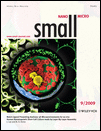Coupled Ionic and Electronic Transport Model of Thin-Film Semiconductor Memristive Behavior
Abstract
The memristor, the fourth passive circuit element, was predicted theoretically nearly 40 years ago, but we just recently demonstrated both an intentional material system and an analytical model that exhibited the properties of such a device. Here we provide a more physical model based on numerical solutions of coupled drift-diffusion equations for electrons and ions with appropriate boundary conditions. We simulate the dynamics of a two-terminal memristive device based on a semiconductor thin film with mobile dopants that are partially compensated by a small amount of immobile acceptors. We examine the mobile ion distributions, zero-bias potentials, and current–voltage characteristics of the model for both steady-state bias conditions and for dynamical switching to obtain physical insight into the transport processes responsible for memristive behavior in semiconductor films.




